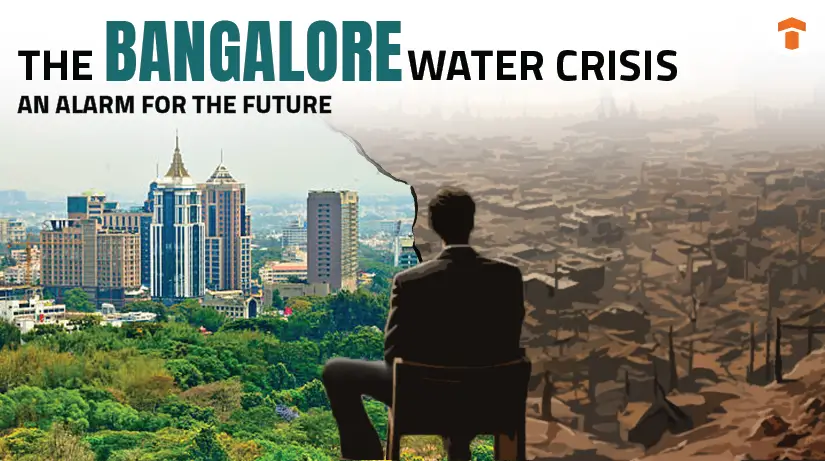The Bangalore Water Crisis: An Alarm for the future
Mar 26, 2024
Category: Industry Trends
Krittika Kar

Bangalore, once known as the Garden City of India, is now grappling with a severe water crisis, signaling a warning for the future of urban water management. Rapid urbanization, unchecked development, and climate change have exacerbated this crisis, posing significant challenges to sustainable water resource management.
Bengaluru is home to over 13 million people and a global IT hub. The issue of water scarcity will probably get worse as summer arrives. With a population of 13 million, officials have resorted to distributing water via tankers as hundreds of borewells dry up owing to low rainfall.
In this blog, we delve into the causes, consequences, and potential solutions to the Bangalore water crisis.
Reasons Behind The Bangalore Water Crisis
People are experiencing an increasing water crisis in Bangalore, resulting in significant shortages in some regions. The reasons for this are:
Lack Of Rain
The globe is experiencing tremendous climate change. So are India, Karnataka, and, of course, Bangalore. The main effect of this change is the lack of monsoons. The city does not receive enough rainfall to recharge its groundwater. The city has already nearly depleted its fossil water reserves. Now the reliance is on rainwater, which is in itself rare.
Accordingly, Karnataka experienced a 38% decrease in northeast Monsoon rainfall between October and December. From June to September, the state received 25% less southwest monsoon rain. Water levels in Cauvery Basin reservoirs such as Harangi, Hemavathi, and Kabini are 39% of total capacity as of 2024.
Decreasing Availability Of Groundwater Sources
Another reason for the Bangalore Water Crisis is the city’s rapid expansion. It has resulted in the lack of natural landscapes that once absorbed rainwater. This reduces groundwater recharge as well as increases surface runoff, resulting in decreased water percolation.
Moreover, borewells supplement residents’ water supplies. However, with less rain and more extraction, groundwater levels are fast diminishing, leading many borewells to dry up.
Water Pollution
Pollution from untreated sewage, industrial discharge and solid waste disposal has polluted water sources, making them unsafe for consumption and diminishing accessible supplies.
According to research done by the Environmental Management & Policy Research Institute (EMPRI), industrial effluents, sewage, and solid waste disposal damage around 85% of Bengaluru’s water bodies.
Inadequate Infrastructure
The city’s infrastructure, which includes water supply and sewage networks, has not kept up with its fast expansion which leads to a water crisis there.
“City officials say 6,900 of the 13,900 borewells drilled in the city have run empty, despite some being bored to depths of 1,500 feet.” Economic Times reported
Thus, this insufficiency exacerbates the difficulties of efficiently distributing water to suit the needs of a rising population.
Political And Legal Challenges
Disputes over water sharing between Karnataka and adjacent states, especially around rivers like the Cauvery, hamper efforts to oversee and secure water resources for the city and lead to the water crisis in Bangalore.
There is an ongoing dispute between the central and state governments over how to distribute and allocate money to alleviate the drought crisis in Karnataka.
Water shortage in Bangalore: Preventive Measures
At the macro level, there are a few efforts that citizen groups and organizations can undertake to reduce water shortage in Bangalore and encourage groundwater recharge:
Reuse Of Sewage Water
The average nuclear family in Bangalore uses approximately 200 liters of water every day to flush their toilets. Consider recycling this water and returning it to the flush. Each home would save 5000 liters of water with a single reuse. This water is also suitable for outdoor washing and gardening.
Connectivity of rivers
The national interlinking of rivers (ILR) concept proposes that rivers be linked together so that water from overflow rivers and regions can be moved to deficient regions and rivers, thereby addressing such water crisis in Bangalore city.
Addressing pollution
Enforcing rigorous controls on sewage treatment, industrial discharge, and agricultural runoff will help combat water shortage in Bangalore. Implementing wastewater treatment facilities and adopting environmentally friendly practices can help minimize pollution in rivers, lakes, and groundwater sources.
Investing in Infrastructure
Provide enough funding for water infrastructure development, upkeep, and restoration. Investigate novel financing techniques such as water tariffs, public-private partnerships and user fees to raise funds for water projects.
| Read More: Most Inventive Architects of the 21st Century
Conclusion
Bangalore’s condition reflects worldwide tendencies, with rising temperatures potentially leading to increased evaporation rates, and worsening water scarcity. Changes in precipitation patterns, which could lead to less rainfall, would also put further strain on the city’s water resources.
This would necessitate effective water management. BIM would effectively contribute to planning, designing, implementing, and managing systems and practices related to water supply, distribution, drainage, treatment, reuse, and disposal. Additionally, it will also help to examine and compare various water options, such as rainwater collecting or greywater recycling.







